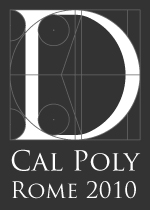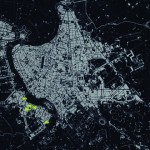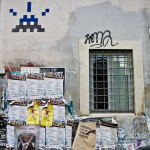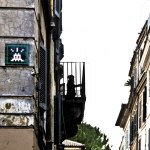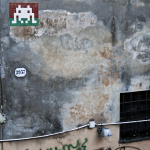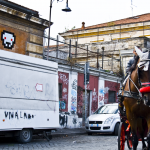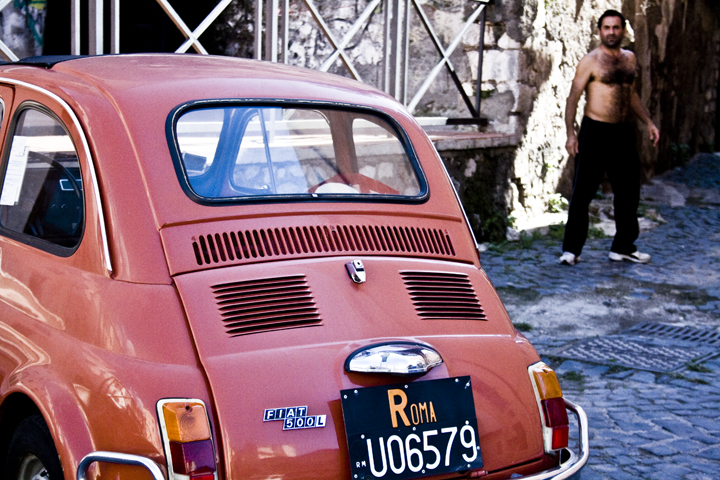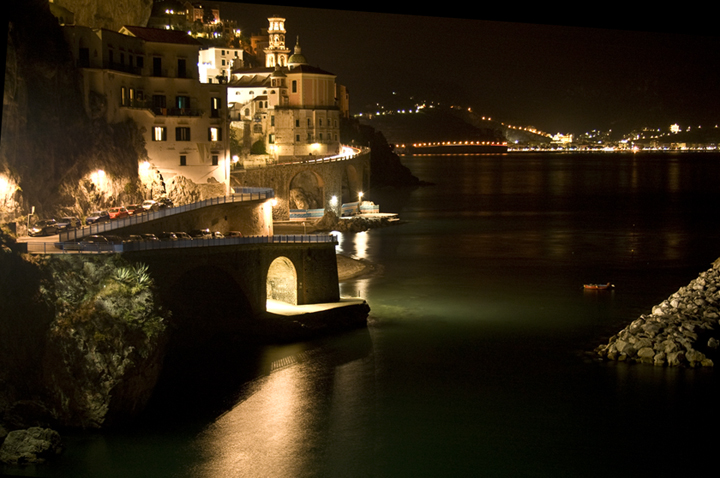From the moment of their inception, these two have known each other. Like casual acquaintances who pass unceremoniously on their way to and from mundane lives, these two know who the other is; their faces, mannerisms, even their names are as familiar to them as their own, but they have never met. Water flows between them, like casual greetings, carrying the remnants of the seasons that continue to pass without so much as a gentle stroke shared between the two. The conversation between metal and travertine, fountain and basin, is one of longing. A perfect match, working forever together towards the same goal, the same ideal, but never connecting in the way that free will would surely enable them to do. Like lovers who missed their chance by a simple slide of a door, this connection will never be realized and the two must forever remain content with living knowing that the other is within reach.
I’ve heard Venice described as a place that should not exist, a city that by all accounts continuously defies logic. There is no place quite like Venice, no city, town, or villa that appears so out of place in this world. I almost wish that before I’d been there I had never seen a postcard or sat through a film containing images of this surreal world, a world that to a regular city dweller looks completely flipped inside out. Imagine the wonder and amazement at a place so magical that scaffolding defies gravity and getting to a destination becomes not an act of mere human transport but a true disappearing act where one moment you’re at a point and the next, who knows. Some say that Venice is a decaying carcass of what it once was, that the city is dying because it really never should have been born but it’s the magic of Venice that keeps it alive. People come to Venice in search of the other; a world separate from their own. People leave their cars behind with no hesitation and willingly lose themselves in the veins of the city, whether on foot or by boat is their own prerogative but the outcome is the same. Venice is Venice and nowhere else in this way; in the way that only Venice inspires stories and awakens the imagination and makes one truly question what is possible and what is not.
 Siena is like a dormant volcano in central Italy. At first glance, it’s just another mountain, a town that keeps quiet, is quaint and is the perfect place for tourists to recreate the days when horses were tied to the doorposts and the city walls were there for more than just photo opportunities. Every once in a while however, Siena erupts in a whirlwind of civic pride. The clues that the potentially enraged mountain is about to awaken are found throughout the city; in the contrada fountains, in the street art showcasing patriotism as well as great artistic talent, and even in the heart of the city, the Piazza del Campo. Some say that a little competition never hurt anyone and in this case it has made Siena what it is. When viewed from the peak of this metaphorical mountain, Siena seems uniformly complex; a maze of terra cotta roofs meant to disguise the rivalries and shelter the alliances. It is the pride and sense of identity that meanders through these mazes that make Siena Siena and nowhere else.
Siena is like a dormant volcano in central Italy. At first glance, it’s just another mountain, a town that keeps quiet, is quaint and is the perfect place for tourists to recreate the days when horses were tied to the doorposts and the city walls were there for more than just photo opportunities. Every once in a while however, Siena erupts in a whirlwind of civic pride. The clues that the potentially enraged mountain is about to awaken are found throughout the city; in the contrada fountains, in the street art showcasing patriotism as well as great artistic talent, and even in the heart of the city, the Piazza del Campo. Some say that a little competition never hurt anyone and in this case it has made Siena what it is. When viewed from the peak of this metaphorical mountain, Siena seems uniformly complex; a maze of terra cotta roofs meant to disguise the rivalries and shelter the alliances. It is the pride and sense of identity that meanders through these mazes that make Siena Siena and nowhere else.
The question of translation is one that looms constantly in our minds as students of architecture and never more so than with dealing with a typology with so much historical baggage such as the ever-present Roman Catholic Church. What is it that makes it obvious that as soon as that threshold is crossed one has entered a sacred space? Form has nothing to do with it; as we’ve discovered form is born from the ritual and as such holds no more power over our senses than the materials used. A good architectural translation searches beyond simple form and finds the essence of what is there to give light to something new. In churches it’s about the feeling of awe that comes with each crossing of the threshold. Whether it’s with the use of light or the change in the quality of air, there is something tangible that stirs feelings of amazement that can make even the firmest non-believer contemplate the existence of something greater.
A phenomenon that I have discovered to be uniquely Roman is that one is never farther than a cobblestone’s throw away from a church. It’s easy to walk around and experience this sense for oneself and we begin to feel aware of when a translation of this sort functions and when it does not. The Jubilee Church, for example is a building that in my opinion translates too directly and loses the essence along the way. I remember opening the door, crossing the threshold, and feeling the same as if I’d entered my living room. It had all the makings of a church, the altar, the aisle, the pews, but nothing there made me feel awestruck. It became very obvious that this example of translation was missing something, it was missing the essence of churchiness, that sense of wonder and almost insignificance compared to the existence of something greater that most feel when entering a sacred space and that is what distinguishes a good translation from a bad translation.
image in progress
How is history made active?
The Trevi Fountain, a monument commissioned by a man whose name means little to most and for a purpose that does not sway even the most instructed tourist. The monument itself stands perfectly still, almost frozen in time as if Pope Clement XII himself instructed Neptune to hold that pose. Muscles contort in the god’s body as he struggles against his orders. His horses prepare to shatter the marble prison they have been cursed with but in the end neither of these impending threats is ever realized. The fountain is historical for sure; it harkens back to the days that the Aqua Virgo served as the source of water for the center of Rome and although the fountain had a set purpose, place, and meaning at the time of its conception, that historical significance has not remained as static as Neptune. Activity is what keeps the fountain alive. The dozens of rose sellers and vendors of one of a kind glass cubes with Roman monuments carefully crafted inside of them, the jaded scholars instructing tourists while holding silly flags to demarcate their status, the lovers of Rome with hopes of one day returning to the city that so enchanted them. Even the covetous eyes of those wondering who benefits from the fountains shimmering metallic mosaic floor. All of these variables around this historical architecture keep it active and will continue to keep it active as long as it continues to serve as the backdrop to this casual, everyday scene.
What does this map say to me?
When I look at this map I see a whimsical, fun, almost secret way of seeing this city. I walk around Rome, find the hidden marker, the image that winks at me from the wall letting me in on a joke that only the elite know, and can not help but smile. The invader has been here, connecting cities around the world in a way only a slightly rebellious soul can do. This map makes me feel like a kid again, searching for more clues and markers in order to solve the mystery. Who is this guy? Why this corner? Why this wall? Why do this at all? I guess the why doesn’t really matter but the result is that this map makes me see this city as the board for a life sized game.
On the Trail of the Invader
- 41.891644,12.461287
- 41.893738,12.478666
- 41.895325,12.472623
- 41.875333,12.474187
- 41.889170,12.470550
- 41.889659,12.471092
- 41.891259,12.470484
- 41.889551,12.473197
- 41.875333,12.474187
- 41.883573,12.474450
- 41.893441,12.476877
Some people remind me of Rome
Some moments you just can’t stage
What stands between a mountain and the sea? Between this mountain and this sea stands a road. A simple road. A road that sometimes slithers up the mountain and sometimes dips down as if to drink from the sea but always consistently present. The road is not biased and it does not choose sides. Its curves caress the mountain just as much as it hugs the sea. If it were not for this road one would not be able to experience sea nor mountain. This road does not simply cut across the mountain; its main purpose is to connect. Cars, scooters, lost pedestrians avoiding the former all flock to this road, not for the road itself but for what is surrounding it. Walking down this road late at night, I realized that because of its presence there, I too stood between the expansive sea and the mountain.
